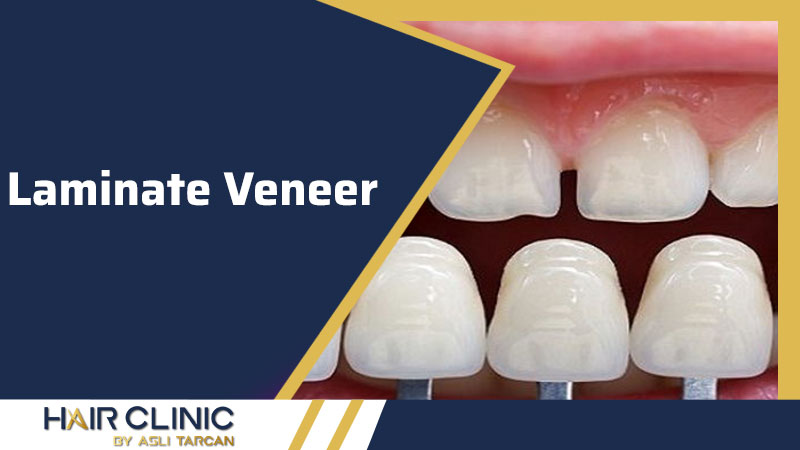Laminate Veneer If you are one who has done a little research to learn some of the best ways to enhance your smile, now you know that laminate veneers are one of the best smile enhancement options a dentist can offer you.
The fact that veneers are used in cosmetic dentistry as a permanent smile enhancement option for almost 40 years means that there has been enough time to perfect this cosmetic dental option. While the majority of dental patients will be good candidates, they will not meet all the requirements for this cosmetic dental treatment.
There are various dental cosmetics services to make your smile better and brighter. One of these is porcelain veneer, also known as “laminate veneer”. It is a thin porcelain shell used to rebuild teeth to make them look natural with a shorter preparation process.
It has greater stability and better aesthetics in the structure of your teeth. Studies have shown that when a porcelain veneer is properly combined with optimal oral care, it can have a high survival rate.
What exactly are laminate veneers?
They are extremely thin shells made using extremely strong porcelain that attaches directly to the front of the teeth. The dentist will make each one so that it fits perfectly on the tooth, which is then attached using a special dental glue. It is an excellent choice for covering a variety of tooth imperfections, such as chips and stains. The fact that this smile change option is not only minimally invasive but also instantaneous makes it a dental procedure that is quite popular among those who tend to have a very busy life.
When to use Laminate Veneer porcelain?
There are different situations or dental situations where you can choose to use a porcelain veneer. It is also a successful and popular choice for many. We have mentioned here the possible condition to use it.
- Painted or discolored teeth
- Chopped teeth
- Slightly fuzzy
- Small gaps between
- Wrong structure
- Loss of calcium in the teeth
Advantages of Laminate Veneer porcelain
Minimal tooth preparation
It is called “minimal preparation” due to the minimal reduction of the teeth for the placement of the porcelain coating.
Stronger and more durable
Porcelain veneer may be thin, but its surface is hard and like glass makes it wear-resistant and resistant to compounds produced by the mouth. It makes its structure stronger due to the cement attached to the tooth enamel with the veneer.
Alternative for full coverage
Natural teeth will be largely intact with minimal changes to match the veneers, unlike others.
Color stability
The color has a slower discoloration rate as time passes due to the compounds in the veneer. Of course, it should also be done with proper regular oral care to maintain its color.
Quick fix
It facilitates and even faster to achieve this beautiful smile due to its minimal preparation.
Who is a good candidate for a laminate veneer?
One of the most important things a dentist will look for in a prospective candidate is healthy teeth and healthy gums. If the patient happens to have oral problems, such as tooth decay, the dentist should first correct these problems. If the patient is a tooth grinder or a jaw clamp, he may not be a good candidate, as these actions can cause a lot of stress, eventually causing the veneers to rupture.
Because this particular procedure is permanent, anyone considering this cosmetic dental option should understand that veneers may need to be replaced over time. The fact that the dentist removes a layer of tooth enamel to attach the veneers means that the patient will have to re-select veneers or a similar option that the dentist may suggest.
What are dental veneers?
There are two main types of materials used in veneer: composite and porcelain. Similarly, there are also two types of applications for dental veneers. Complete veneers are restorations that cover the entire surface of the crown teeth and are known as “all ceramics”. On the other hand, laminate veneers are thin layers that cover only the surface of the tooth.
Lamina is the Latin word for “leaves”. In this method, the entire surface of the teeth is not cut, only the front surfaces are cut 0.3 to 0.7 mm. Therefore, the loss of healthy tooth tissue is kept to a minimum. In this process, porcelain veneers are attached to the cutting area.
Porcelain veneers
Perfect teeth and beautiful smiles; Unfortunately, some of us were not born with these things. Porcelain veneers are cosmetic dental tools and are ideal for patients who want to eliminate what they see as defects in their smiles.
A veneer is a thin shell of high-quality ceramic that is attached to the front surface of the teeth. They can make a direct visual difference. The ceramic veneer looks like natural tooth enamel, which is made individually for each patient. Carefully match the colors and use the veneer to hide chips, cracks, and gaps between the teeth. Veneers can also be used to change the size and shape of a tooth. They are difficult to stain and can last 10 to 15 years.
The best candidates for veneers are patients who have healthy teeth and gums. Patients with tooth and gum decay usually qualify for this treatment only after these issues have been and are successfully addressed.
Porcelain Veneer vs. Bonding
Veneers are thin pieces of porcelain that are glued, not glued, to the front teeth. Welding uses a composite resin that is immediately applied, shaped, and polished to fill gaps, chips, or broken teeth. Porcelain veneers are made to order in our laboratory and look like your original teeth. Veneers are harder than the composite resins used in welding and are more stain-resistant.
Porcelain Laminate Veneers require adequate tooth enamel
Laminate Veneers porcelain is attached to the enamel of your teeth and is not a good choice when there is insufficient enamel on your tooth. As porcelain is fragile, it needs reinforced backing material. The enamel on your tooth looks stiff and prevents the porcelain from bending and breaking.
When there is insufficient enamel, porcelain requires the dentin layer of the tooth to strengthen it, but dentin is more likely to allow the porcelain to deform and increase the chances of veneer rupture. If there is not enough tooth enamel, another tooth restoration option should be chosen.
Composite porcelain veneer
Now that you have read about the various materials used in dental veneers, which one should you go for?
In general, composite veneers are cheaper than porcelain. Composite veneers are sculpted directly on the teeth, while porcelain veneers must be created in an off-site laboratory. While composite veneers can be reversed after the procedure, porcelain veneers involve the restoration of real teeth.
However, this also depends on the extent of the damage to the tooth. In the event of severe damage, composite veneers may not be used.
While porcelain veneers may be more expensive, they are also much more durable. In other countries, porcelain veneers need to be made in off-site laboratories, but dentists with CAD / CAM technologies can make veneers on-site.
When it comes to removing the surface of the teeth, full crown veneers require the most removal. This is followed by laminate veneers and finally by composite veneers.
Do you need a veneer?
So who are the people who will benefit most from veneer? If you have:
- Small teeth that can not be treated with braces
- Widely spaced teeth
- The teeth were ground
- Dull and yellow teeth
- You can look at veneers for long-term improvements in your personal dental health.
What happens when I get dental veneers?
First, the dentist removes 0.5-0.7 mm of the surface from the teeth. Next, a silicon impression is created to create a test set of veneers. This impression is then sent to the laboratory, which makes a model of candles. Upon completion of the model, the patient can confirm whether the shape and length of the veneer is satisfactory.
A temporary material is placed over the existing teeth and then developed in the laboratory as real veneers. The procedure is completed as soon as the veneers are attached to the real teeth.
Veneer finish of the same day
This could be done in just one day. In general, 3D design and printing with CAD / CAM technologies can be done on the spot at the dental clinic in the morning. This eliminates the need to spend more time creating patterns and candle patterns.
Then the milling center makes the veneers the same day. Most dental clinics have on-site grinding centers.
- In cases of irreversible discoloration with dental whitening,
- Teeth with poor structure and shape,
- In space therapy (space closure),
- When repairing broken or damaged teeth,
- Replacement of old fillings with worn color and structure
- In the fixation of accumulated and crooked teeth (may be preferred as an alternative cosmetic treatment)
Who can be treated with a porcelain veneer?
Almost anyone can be treated with a porcelain veneer.
When is porcelain veneer treatment not applied?
Porcelain veneer treatment can not be applied to patients with jaw deformities, such as severe gingival recession, bad habits such as nail-biting and pencil biting, as well as severely full teeth and embarrassment.
How many sessions does porcelain veneer processing need?
If your gums do not need any treatment or cosmetic surgery, the treatment is estimated to be completed in 2 to 3 sessions within 1 week.
What are the stages of porcelain veneer processing?
In the first session, the impression of your teeth is taken before the cut and the received model is examined. Then your teeth are cut and the impression of your teeth is repeated using sensitive impression material. In the next session, the leaves are placed on your teeth.
Will porcelain sheets fall from porcelain?
The level of adhesion is very high in state-of-the-art products. If the dentist pays attention to the technical details of accuracy, you can use laminated porcelain veneers as if they were your natural teeth.
What is the service life of porcelain plastic veneers?
Porcelain veneers can be used for years with proper oral care. They are made of porcelain and its excellent quality ensures that they are more durable than veneers from other materials. They are more resistant to stains and corrosion. It is necessary to pay attention to oral care to extend their lifespan.
What are the advantages of a porcelain veneer?
The desired appearance is achieved with a minimum cut of 0.3 to 0.7 mm. The process takes an average of 7 to 10 days.
They are produced from durable, discoloration resistant, and durable materials.
Having the desired aesthetic properties (color, shape, etc.) without destroying the natural structure of the teeth can be achieved by processing porcelain veneer. No small or minimal changes are applied to the veneer. The cut layer ranges between 0.3 and 0.7 mm.
The model of your teeth is double and the design of the teeth is completed based on this model. In other words, before the operation, the planned changes may appear as a demonstration at the beginning of the treatment. This is called “mock-up”.
The porcelain surface of the veneers is smooth, therefore it reduces the possibility of plaque accumulation and staining due to smoking, etc.
It does not discolor due to external factors such as coffee, tea, and smoking.
It is highly resistant to corrosion.
Are you ready for a new smile?
Improving your overall smile is one of the best things you can do for yourself. No one should feel the need to hide their smile and that is why we offer a variety of professional smile change options. If you were expecting to find the right dental procedure to correct your smile, laminate veneers may be your best choice. To find out for sure, call us today to schedule an appointment at a convenient time.
To make your decision on laminate veneers against dentures, call our office to schedule a consultation. We will discuss with you the benefits of each of these dental cosmetic techniques to determine which treatment is right for you.



